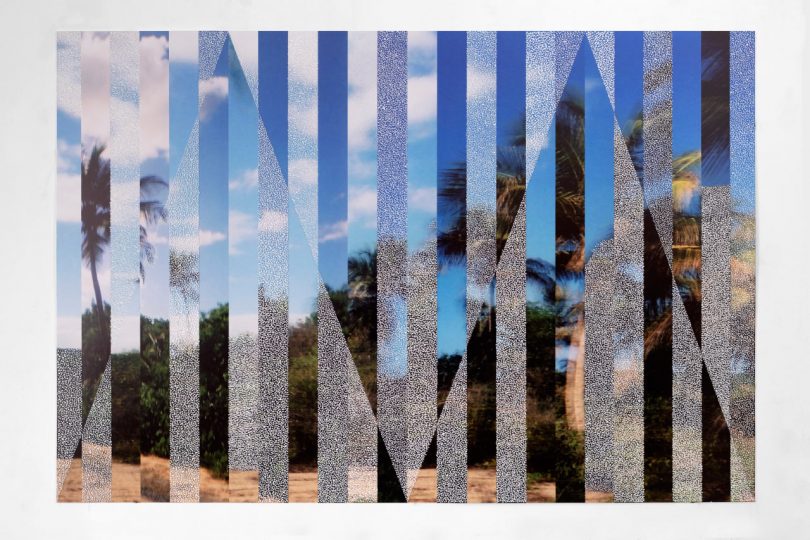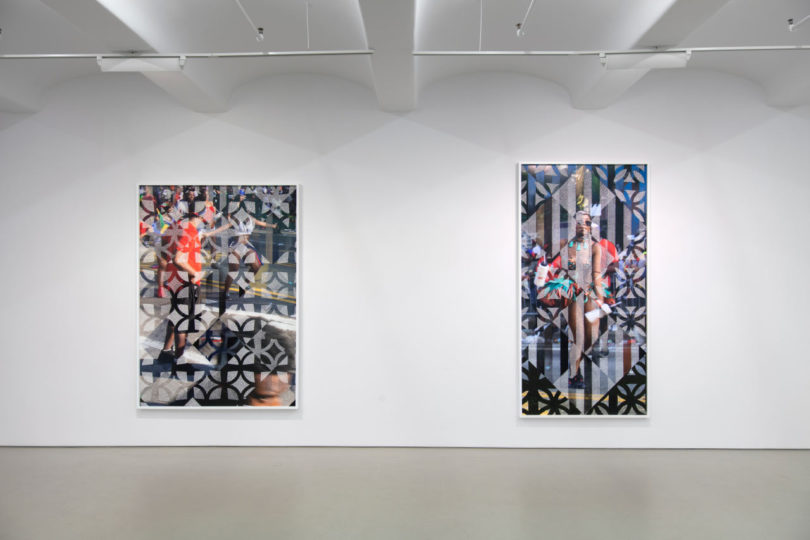Paul Anthony Smith pierces and picks the surface of his photographs thousands of times to create a surface that is both scarred and dazzling; that is visually magnetic and yet obscuring. The textured images are on view in a double-venue show titled “Junction” at two Jack Shainman Gallery locations in Chelsea, New York through May 11th, 2019.
Paul Anthony Smith uses a technique he calls “picotage”, to cut into and lift the surface of the photograph into geometric patterns over images he personally photographs. When viewing the works in person, the greatest surprise is that the white sections change and introduce NEW patterns when viewed from the right or the left. Visible in the two images below, this strange phenomenon is the result of the angle he gouges the paper. When viewed from an angle, the scars in the paper will either mask their damage or reveal more of the torn white paper. So the thick white bars in “Junction” (below) will split into a dark stripe and a light stripe when viewed from the side, and then reverse when viewed from the opposite side. In the same way, Smith can reveal or hide select portions of the image when viewing from an angle.
The content of the images explores “the rich and complex histories of the post-colonial Caribbean and its people”. Smith was born in Jamaica and currently lives and works in Brooklyn, so the images are photographed in both places. For the New York images, dancers and crowds are captured at the West Indian Day Parade, an annual celebration of Caribbean islands and culture. The geometric patterns are references to “breeze block fences”, an architectural element in the Caribbean that are designed to partially veil and obscure. Those patterns perform that same sense of voyeurism, mystery, or an uneasy sense of imprisonment or separation from the subjects of the image. A tropical beach when viewed through a chain-link fence, for example, doesn’t feel much like paradise.
And yet, there is joy in every image, as those same scars seem to sparkle like sequins as you walk around the gallery.
These works speak to extremely complex and often dark personal histories of displacement, colonization, belonging, and cultural pride. And I’m not an expert on any of that. But that’s exactly why this work is so incredibly successful, and why I’ve visited 3 times now.
The best art in the world doesn’t scream or lecture at a viewer, nor does it gently satisfy with something known. Great art makes you curious about something that has always been there, but wasn’t in your personal field of view. Paul Anthony Smith has beautifully damaged photographs with exceptional precision, and in doing so has locked the viewer (joyfully) in front of his images for several minutes as patterns shift with angled views. And what remains when walking out of the gallery is an insatiable curiosity about these histories and issues. For me personally, I’ve already marked my calendar for the next West Indian Parade.
What: Paul Anthony Smith “Junction”
Where: Jack Shainman Gallery, 513 W 20th Street and 524 W 24th Street, NYC
When: April 4 – May 11, 2019
All images © Paul Anthony Smith. Courtesy of the artist and Jack Shainman Gallery, New York.
from WordPress https://connorrenwickblog.wordpress.com/2019/04/23/the-dazzling-damaged-photographs-of-paul-anthony-smith/













No comments:
Post a Comment